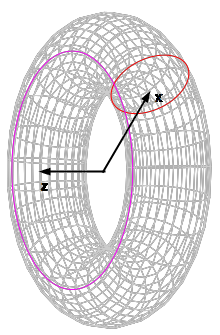I was trying to find the moment of inertia of the Torus with respect to the axis in the center perpendicular to the bigger circle's plane; see image:
So: the radius of the magenta circle is $\rho$, the radius of the red circle is $R$, and I want $I_z$, $z$ being the axis that touches the center point of the magenta circle and is perpendicular to the plane of the magenta circle.
What have I done?
Well, first I integrated the moment of inertia of the disk with respect to a axis perpendicular to it's center, integrating small rings. My answer matched the tabled result: $\frac{1}{2} MR^2$. In this image, the $Z'$ axis:
Then, I used the perpendicular axis theorem to get the moment of inertia with respect to one axis that is a diameter of the circle (for example, $I_x'$ in the image). I got another expected result: $\frac{1}{4} MR^2$.
Ok, so now I use the parallel axis theorem to get the moment of inertia of the red disk in the torus with respect to the original $I_z$ axis. This result is obviously not tabled but the math is very simple and it gave me: $M(\rho^2+R^2/4)$.
Ok. That's for a disk of mass $M$. But if the disk has mass $\mathrm{d} m$, and they are all the same distance from the center axis, I just integrate all the disks in the torus to get the final moment. As you can see, this integral will just be a simple sum, and the result will be the same:
$\mathrm{d} I = \mathrm{d} M\left(\rho^2+R^2/4\right)$
But $\mathrm{d} M = \left(\mathrm{d} V / V\right) \cdot M$, the volume of the disk over the total volume times the total mass.
But the volume of the red disk is $\mathrm{d} r' \cdot A$, and the total volume is $2\pi\rho A$, so $\mathrm{d} M = \dfrac{M}{2 \pi \rho}\cdot \mathrm{d} r'$.
This depends on a new variable $\mathrm{d} r'$ that is independent from $R$ and $\rho$; see, those are fixed now. So when I integrate $\mathrm{d} r'$ form $0$ to $2 \pi \rho$, as expected, I get the same result: $I = M \left(\rho^2+\dfrac{R^2}{4}\right)$.
That seems good, but again that Wikipedia table says it should be $M \left(\rho^2+\dfrac{3R^2}{4}\right)$. And I have no idea where this $3$ factor is coming from.
Seems like a simple problem, but it's bugging me a lot.




